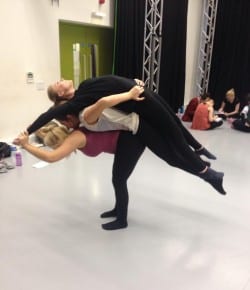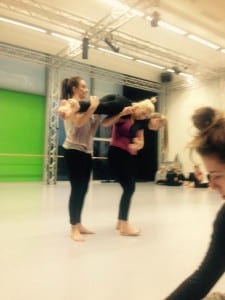The workshop started by viewing week 7’s assessment video. From the video i found several features in my dancing which i had never noticed before. I found i often became a stable 4 point structure for my base, kneeling with hands in front. This made me notice that i am not taking enough risks and need to remove this habitual movement. However, i found my self giving my weight quite a lot, which was surprising as i feel like i do not do this enough. I feel like my ability to form improvisation has become stronger since the start of the semester. I am able to perform lifts as well as being lifted, and i view my self working with each individual instead of restricting my self to the people i usually dance with. Viewing the other dancers in the class i noticed a real improvement. People giving weight and receiving weight in a safe and sensible manner. This i found re-assure as i could view the effectiveness of improvisation, as each dancer i viewed as original and imaginative.
Coming into the practical side of the workshop we experimented with more developed lifts which required the pelvis being higher than usual, whilst moving through space. The first lift, we started lying on the floor and indicating with just our pelvis, applying movement through space. When i became comfortable with this pelvic movement we began to work in partners. the over dancer was to lay or sit on the floor and rise their pelvis whilst whilst allowing leg moment, in order to transfer their weight onto their partner whilst they were creating several levels, and structures for the over dancer. I found this task fairly difficult as the start struggling to rise my pelvis higher than previously asked. My partner is fairly tall. This i found a beneficial challenge as it made me rise my pelvis even higher.
The practice of this then lead onto trying to apply movement whilst being hooked. Here i found it fairly difficult to direct my partner and it also applied pressure and a pull on my arms. It restricted movement and added unnecessarily weight. However, when we went on to just trust each others movements the task became less strenuous and it began to move more fluidly across the space.I felt less weight from my partner, and felt a positive connection throughout the experiment. The next task i found fairly difficult. It required us to experiment with raising our pelvis.This required one person placing their hands on their knees bent over with a slanted back. Then the other partner was to higher their pelvis whilst raising on their toes, in order to pour their pelvis into the other dancer’s. Developing from this the partner was to toll their pelvis higher up the other dancer’s back and slide down their shoulder. It took me and my partner several tries to reach fluidity. The difficult part we found was raising our pelvis high enough in order to be successful. When providing the surface for my partner i found it difficult to find the perfect balanced position. I became off balance due to my legs being too far in. After adjusting this, i found it easier to be a strong base for my partner. I look forward to using this lift in the jam as it challenged my ability.
The final part of the workshop required us in a group to set an improvisation score for the open studio in the near future. We looked into and developed ideas from Jamie Stover’s Some Considerations When Structuring an Improvisation. His reading was based on scores and how to differentiate your score from others. He gave instructions to help develop a score by advising to either follow a strong set structure or allow the dancers to improvise from instinct and their self influences throughout the jam. Also, the score could either develop an understanding for the audience or allow the score to be purposeless. A further decision was to decide whether or not we were to use visual markers or follow the rhythm of the piece. Taking from our last research lab we were eager to focus on the use of space and if a set direction allows a easier flow of improvisation. We came up with these certain rules;
1. At least two dancers out at all time, to allow viewing time
2. Move in the opposite direction from which you first started
3. When another dancer makes the duo a trio they are to initiate the change of direction.
When performing a small jam and applying these scenarios, we found the instructions about direction worked efficiently, creating more fluidity between movement and lifts. It was rather difficult to visualise the third dancers initiated direction. We also found that even after experimenting new lifts during the workshop, we still found it difficult to get the lifts from the floor into the air. From this we will imply new rules in order to allow us to raise our hips and raise from the floor. An example of this would be to apply a rule which requires staying off the floor. I am exciting, and eager to view our results.
Our final task was to devise a contact score in groups to be performed at an open studio event in a week’s time. In order to create our score, we referred to Jamie Stover’s Some Considerations When Structuring an Improvisation, which identified the two ways that a score could differ. Firstly a score could either follow a strong structure that the dancers religiously keep to or the dance itself could influence and change the original score depending on the dancer’s performing. Secondly a score can either be formal enough for the audience to follow and understand the action or completely invisible with no particular purpose or ending. In relation to Stover’s considerations, we also had to decide whether the score include visual markers, how much the dancers needed to rely on the rules and what spatial rhythm structure the score would follow. Following on from our research labs, we wanted to primarily focus on a way to transition between levels fluently and diversely as well as experiment with using different tones and speeds within our score.
So far our score follows these rules, however these will be developed further before our performance:
- To start, each dancer asks an audience member to pick a number between 1 and 10 – if the number is even you start on the floor, and if odd you begin on a higher level
- If you are on a lower level, the movement must be slow, sustained and controlled
- If you are on a high level, the movement must be faster
- Whenever transitioning between levels you have to find the most complicated route
- Everyone brings their own rule to the score which is applied throughout the score but no other member of the group knows
- You must exit the space after dancing with 2 dancers
- You can only enter the space after seeing 3 lifts performed
- If a duet is left in the space, the others create a corridor for them to travel down

![IMG_6870[1]](https://ellieosullivancontactimprov.blogs.lincoln.ac.uk/files/2014/11/IMG_68701-225x300.jpg)
